The second happiest country in the world (according to the United Nations World Happiness Report) is also one of my favourites! With so many pristine and extraordinary places to choose from, it was a tough decision, but I’d love to share some of my favourite spots with you based on my many visits…
1. The Fjords
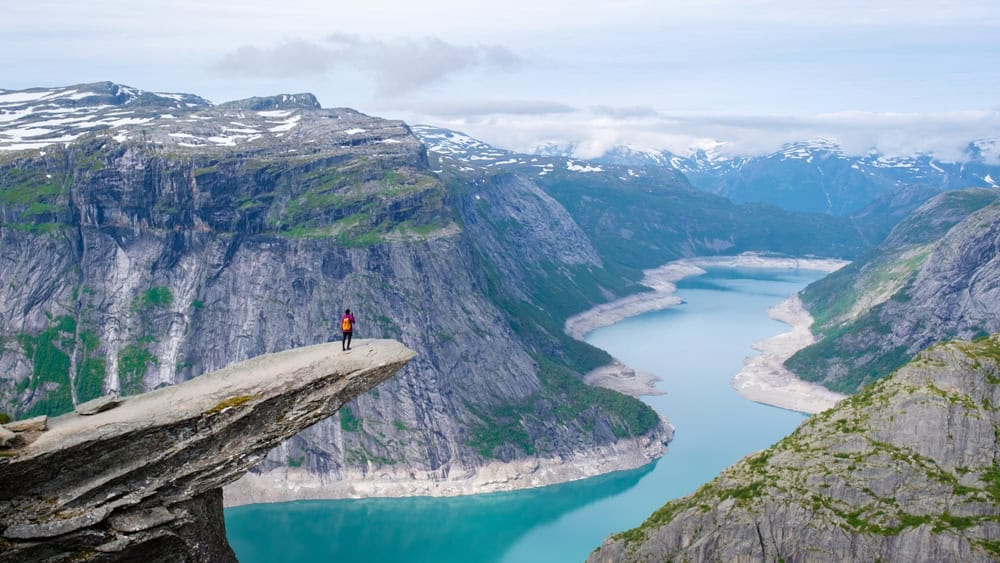
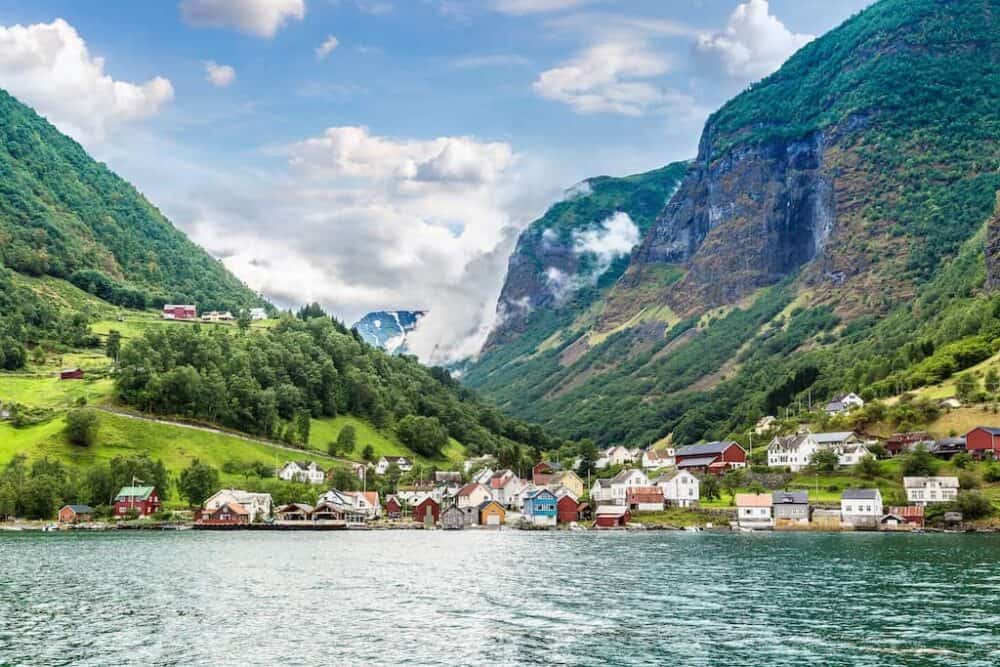

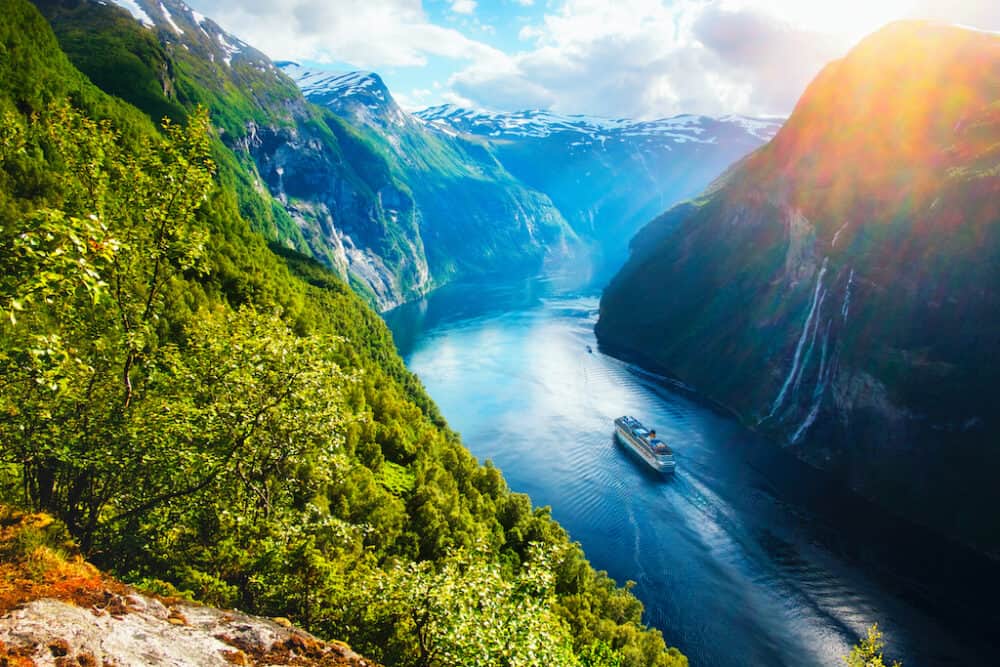

The UNESCO-listed fjords are now on many travellers’ bucket lists! I discovered that the collection of steep, glacially-carved valleys were seriously breathtaking with exceptionally dramatic landscapes of towering cliffs, green hillsides, spectacular waterfalls and sparkling blue waters, dotted with quaint villages with traditional wooden houses. I loved how unearthly serene they were – to me, they felt like a peaceful escape from the hustle and bustle of everyday life!
Located along the western coast of the country, the fjords stretch from the southern region near Stavanger to the northern reaches near Tromsø. Bergen, which is known as being the gateway to the spectacular fjords, is also Norway’s second-largest city. Formed by glacial activity over millions of years, these stunning landscapes are now listed as UNESCO World Heritage sites!
I flew into Bergen and spent an idyllic two weeks here, I went on a cruise to the majestic Geirangerfjord (which I thought was the most scenically impressive of all the fjords), hiked the famed Pulpit Rock and Trolltunga (the Instagram-famous troll’s tongue cliff!), kayaked in the serene waters of Nærøyfjord, marvelled at the cascading waterfalls in picturesque Flåm, witnessed the spectacular Northern Lights near Tromsø, took a trip to Jostedalsbreen glacier (the largest ice sheet in Europe) and explored the gorgeous historic city of Bergen which had an attractive UNESCO-listed Bryggen Hanseatic wharf and pretty colourful wooden houses lining its old harbor.
- Location: Western part of the country.
- Best time to visit: Spring and Summer (for green landscapes, fjord cruises, and pleasant temperatures).
- Activities on offer: Hiking, fjord cruises, kayaking, sightseeing, and visiting scenic viewpoints.
- Accommodation: Ullensvang Hotel, Molde Fjordhotell, and Hotel Aak.
- Map Location and Directions
My personal highlights…
- Staying at the 4-star Hotel Union Geiranger Bad & Spa – I loved the Insta-worthy views of the Geirangerfjord from the outdoor infinity pool, the outdoor hot tub, the holistic spa, having breakfast in the pretty rooftop garden and the cool onsite vintage car museum (especially the mint blue Cadillac from 1919)!
- Visiting my favourite fjords which were Sognefjord which was the longest, deepest, and most celebrated of the fjords and the locals told me they called it the “King of the Fjords,” Hardangerfjord the second-longest fjord which had a breathtaking beauty and Nordfjord which was also highly photogenic. I loved listening to the folklore from the locals especially the tales of trolls!
Book A Trip!
We can book your trip hopping around Norway’s beautiful places through our free, top-rated travel planning service!
2. Ålesund




This gorgeous coastal town completely charmed me! I discovered it was a true gem, with striking, Instagram-worthy Art Nouveau architecture and very attractive colourful buildings lining the streets and waterfront, all set against a breathtaking fjord backdrop. I loved its upbeat cultural vibe, its bustling maritime atmosphere, and thriving art scene!
Nestled on the west coast of the country, it sat on a narrow peninsula surrounded by several islands and the Norwegian Sea, near the much-loved Geirangerfjord and Hjørundfjord (in Møre og Romsdal county. It’s home to around 47,000 people, and is famous for its striking Art Nouveau architecture.
I drove a long seven hours from Bergen but it was worth it! I stayed for three days and visited the Art Nouveau Centre and learnt about the town’s architectural history, climbed the 418 steps to the Aksla Viewpoint and saw gorgeous panoramic views of the archipelago, wandered through the picturesque streets of the old town, took a day trip to the nearby Geirangerfjord (which was seriously stunning!), and enjoyed local cuisine in restaurants located along the bustling harbour.
- Location: Northwestern part of the country.
- Best time to visit: Late Spring to Summer (for Art Nouveau architecture and outdoor activities with good weather).
- Activities on offer: Hiking up Aksla viewpoint, exploring local trails, boat tours, and enjoying local cuisine.
- Accommodation: Hotel Brosundet, Storfjord Hotel, and Quality Hotel Ålesund.
- Map Location and Directions
My favourite highlights…
- Dining at the gorgeous Apotekergata no. 5 restaurant – I loved the trendy rustic-chic decor, the beautifully restored pharmacy building dating from 1907 it was housed in, and my divine Porchini mushroom risotto which came with a lemon ricotta and kale chips!
3. Lofoten Islands
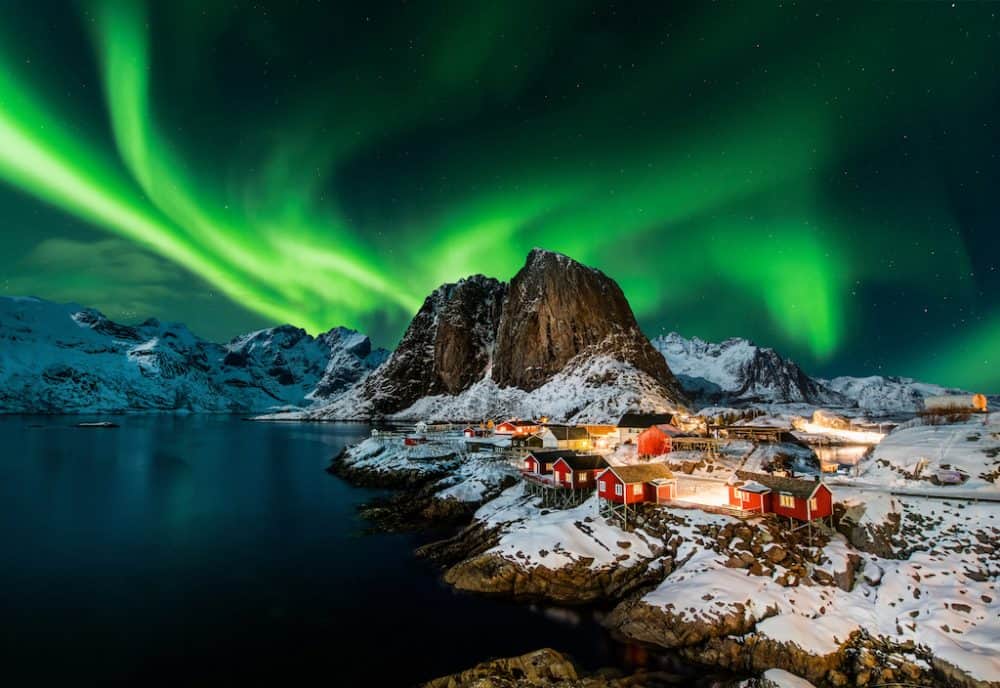



This group of islands are fast becoming a much-sought after travel destination! I personally discovered they were indeed truly breathtaking with steep mountain peaks, shimmering waters, a rugged coastline and post-card pretty fishing villages with traditional red rorbu (fishermen’s cabins).
It felt tranquil and awe-inspiring, with a vibe of untouched wilderness, rich Nordic heritage, a simple way of life and natural beauty that created a serene, almost mystical atmosphere!
Tucked away in Norway’s Nordland county within the Arctic Circle, they stretched along the Norwegian Sea. Home to around 24,000 people, they boast a rich Viking and fishing heritage, with settlements dating back over 1,000 years. Their cod fishing industry has sustained the region for centuries, but today, they attract over a million tourists annually, drawn by their extraordinary beauty and Northern Lights viewing opportunities.
I flew into Leknes Airport (located on Vestvågøy, one of the main islands) from Oslo during the winter and stayed for an awe-inspiring six days. I had the magical experience of spotting the Northern Lights from the remote beaches in Uttakleiv, went on a whale-watching tour from Andenes (orcas, sperm whales, and humpback whales migrated to the Norwegian coast to feed mostly from October to January).
- Location: Northern part of the country, within the Arctic Circle.
- Best time to visit: Summer (for the Midnight Sun, long days, and water activities like kayaking).
- Activities on offer: Hiking, kayaking, visiting traditional fishing villages, wildlife viewing, and rock climbing at Svolvaergeita.
- Accommodation: Scandic Svolvaer, Nusfjord Arctic Resort, and Reine Rorbuer.
- Map Location and Directions ( the islands are are connected to the mainland by road)
My favourite highlights…
- Staying in the unique Nusfjord Village & Resort – I loved staying the super-cute renovated village fishing huts which came with custom-made furniture and cosy rustic-chic decor (especially the very trendy drift wood coffee tables!), the onsite spa and gazing at incredible sea views while eating my breakfast of Bolle (a sweetened bread roll) and lingonberry jam!
4. Bergen




This gorgeous city is known as being a gateway to the Norwegian fjords! Part of the inspiration for the fictional Frozen in the hit Disney animation, I found the city to be a wonderful gem of a place with a colourful Bryggen Wharf lined with attractive wooden buildings, medieval landmarks, charming timber hillside houses, and a stunning fjordside setting, all framed by misty mountains and lush green landscapes! I loved its laid-back vibe and historic charm mixed in with modern vibrancy!
Located on Norway’s west coast in Vestland County, it sits between the North Sea and the surrounding Seven Mountains, serving as a gateway to the Norwegian fjords. Founded in 1070, it has a rich maritime history as a key Hanseatic trading hub and was once Norway’s capital. Today, it is the country’s second-largest city, home to around 290,000 people, and is known as one of the rainiest cities in Europe!
I flew in to Bergen Airport from Oslo (which took an hour) and stayed for a very charming three days. I strolled through the historic Bryggen Wharf, rode the Fløibanen funicular to the top of Mount Fløyen and saw superb panoramic views, visited the Edvard Grieg Museum at Troldhaugen, took a scenic fjord cruise to Nærøyfjord, hiked the trails of the Seven Mountains which surrounded the city and browsed its quirky independent stores and cute al fresco cafes.
- Location: Southwestern coast of the country.
- Best time to visit: Spring and Summer (for mild weather, festivals, and exploring the historic waterfront).
- Activities on offer: Riding the Fløibanen funicular, exploring Bryggen Wharf, hiking Mount Fløyen, and visiting museums.
- Accommodation: Hotel Zander K, Det Hanseatiske Hotel, and Clarion Hotel Admiral.
- Map Location and Directions
My highlights…
5. Trolltunga
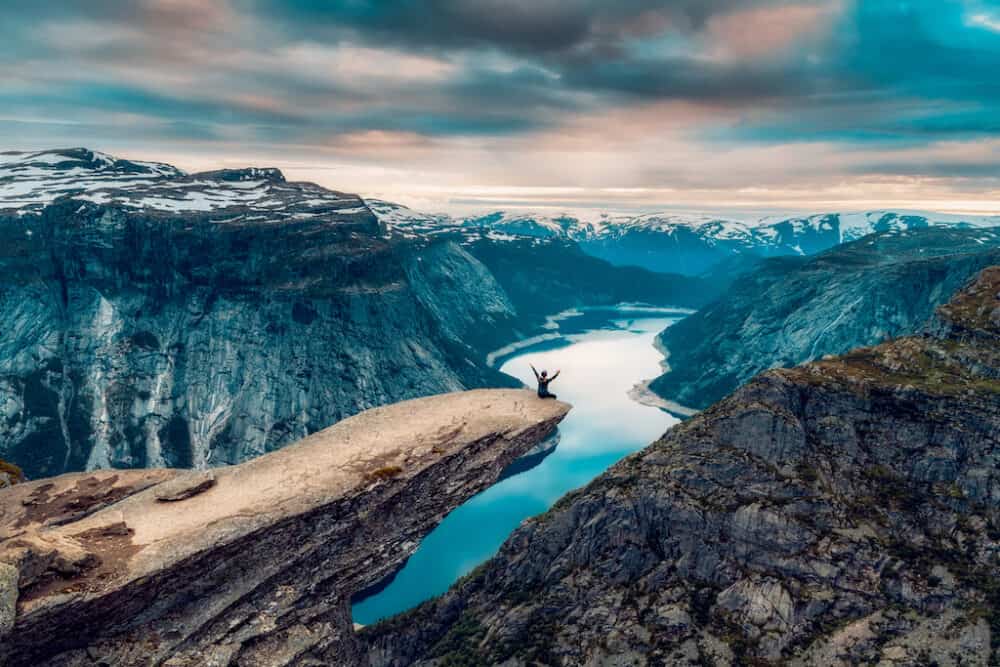



This dramatic cliff is an Instagrammer’s dream! Otherwise known as the ‘troll’s tongue’, it’s one of the most spectacular scenic cliffs in the country and I was in awe of its dramatic, gravity-defying rock ledge which jaw-droppingly jutted over a stunning fjord and had truly breathtaking panoramic views of Norway’s rugged wilderness! It felt both epic and exhilarating!
Located in Vestland County in western Norway, about 20 km from the town of Odda, it was formed during the last Ice Age, around 10,000 years ago, through glacial erosion. As the ice retreated, it sculpted the landscape, leaving behind this striking cliff that extends horizontally from the mountain, hovering an incredible 700 meters above Lake Ringedalsvatnet!
I have to admit it wasn’t easy to get to though. I drove from Bergen to the nearby main base of Odda town, from there it was a 7 kilometre drive to Skjeggedal and then it was a long 27 km round-trip which took me nine hours! On the hike there was significant elevation gain (around 800 meters) so I was glad I was physically fit enough to do it and properly prepared. It took a full day but it was honestly very worth it – it was a definitely one of those once in a lifetime travel experiences!
Like many of the hikers I chose to stay overnight and watch a truly spectacular sunrise at the cliff. I camped up in the designated camping area close to the cliff where I set up a tent, there were a few hotels and several mountain lodges in the area but these were located close to the town of Odda. There were also guided hikes available which was the safer option!
- Location: Western part of the country, near Odda.
- Best time to visit: Summer (to enjoy the challenging hike with the best conditions and longer daylight).
- Activities on offer: Hiking the Trolltunga trail, rock climbing, camping, and enjoying scenic viewpoints.
- Accommodation: Trolltunga Hotel, Hardanger House Hotel, and Rosendal Fjordhotel.
- Map Location and Directions
My highlights…
- Gazing at the Insta-worthy views from the vertigo-inducing cliff was a very special moment! I could see the vast, blue Ringedalsvatnet lake below and the snow-capped towering peaks and moody grey cloud formations which surrounded it – it all added to the mystical atmosphere!
6. Oslo




I thought Norway’s modern capital was also very attractive! I really enjoyed its harmonious blend of old and new architecture, from the historic Akershus Fortress to the sleek, modern Opera House, along with its vibrant cultural scene and abundant green spaces – all set against a backdrop of dense forests and the shimmering Oslofjord. I thought it mixed contemporary chic and historical charm just perfectly!
Yes, it was expensive, and yes, it didn’t have a long list of world-famous attractions, but I thought it was clean, laid-back and had a very beautiful setting. I was also really admired its progressive, eco-friendly friendly and its focus on sustainability and green spaces.
It was located in the southeastern part of the country at the head of the Oslofjord, it was founded in 1040 and has been Norway’s capital since 1814. Today it’s home to around 697,000 people, which makes it the country’s largest city.
I flew in from Oslo Airport from London Heathrow and I stayed for three days. That was enough time to explore the Viking Ship Museum, marvel at contemporary art in the Astrup Fearnley Museum, stroll through the historic Vigeland Sculpture Park, catch a moving performance at the Oslo Opera House, see the Edvard Munch’s famous painting, ‘The Scream’ at the Munch Museum, and unwind in the pretty waterside Aker Brygge and Tjuvholmen districts.
- Location: Southeastern part of the country.
- Best time to visit: Spring and Summer (for cultural festivals, mild temperatures, and city sightseeing).
- Activities on offer: Visiting museums, exploring Vigeland Sculpture Park, fjord cruises, hiking in Nordmarka, and enjoying local cuisine.
- Accommodation: Thon Hotel Rosenkrantz, Hotel Continental, and Hotel Bristol.
- Map Location and Directions
My highlights…
- Staying at the 4-star Saga Hotel Oslo, WorldHotels Crafted – I loved the chic boutique decor, the restored 1890s building it was housed, the use of natural materials like wood in my guest room and the superb location on the fashionable Bogstadveien Street!
7. Flam




This small village was so pretty it felt like a postcard! I discovered it was home to breathtaking fjord views, stunning natural scenery, a historic church and the dramatic Flåmsbana Railway, which wound through the surrounding mountains. It me, it felt serene and timeless – like a true tranquil escape!
It was tucked away in the heart of western Norway, at the inner end of the Aurlandsfjord (a branch of the larger Sognefjord). It had a history rooted in its strategic fjord location and a current population of around 350 residents. It also attracts many visitors who are drawn to its beauty as well as the iconic Flåmsbana railway.
I arrived from Bergen via the scenic Flåmsbana Railway which took me four hours and I stayed for an idyllic three days. I rode scenic Flåmsbana railway (and found out it was one of the steepest train rides in the world!), cruised the stunning Aurlandsfjord and Nærøyfjord, hiked the picturesque surrounding trails, visited the historic Flåm Church, explored the interesting Flåm Railway Museum, and enjoyed delicious locally crafted brews at Ægir Brewery.
- Location: Western part of the country, in the Aurland municipality.
- Best time to visit: Late Spring to Early Fall (for scenic train rides and outdoor activities).
- Activities on offer: Riding the Flåm Railway, fjord cruises, kayaking, RIB boat tours, and hiking trails in Aurlandsfjord.
- Accommodation: Fretheim Hotel, Flåmsbrygga Hotel, and Heimly Guesthouse.
- Map Location and Directions
My personal highlights…
- Taking a 15 minute drive from Flam to the incredible nearby Stegastein Viewpoint which was a modern construction made of wood and glass which extended 30 meters from the mountainside. I have to admit it was very vertigo-inducing but I loved seeing breathtaking views over the spectacular Aurlandsfjord!
8. Henningsvær




I thought this was one of the prettiest villages in the Lofoten Islands! After discovering it and being in awe, I felt it deserved a special mention of its own! Here, picturesque colorful traditional Norwegian fishermen’s cabins, scenic harbours, cosy eateries, and a bustling waterfront sit perched on rugged islands, set against a backdrop of mirror-like waters and towering granite mountains. To me, it felt laid-back, with a unique artistic vibe blended with a strong sense of local tradition and community.
It was located in the Lofoten Islands in the Nordland county, situated within the Arctic Circle in the northern part of country. It’s history is rooted in fishing dating back to the 18th century and today has a population of around 500 residents.
I flew into Leknes Airport and then drove two hours to reach Henningsvær, once here I explored the vibrant fishing harbour, visited the cool KaviarFactory and saw contemporary art exhibitions, enjoyed local cuisine at Fiskekrogen Restaurant, strolled through the charming streets lined with quaint shops and galleries, managed to catch a magical glimpse of the Northern Lights and soaked up the incredible scenery!
- Location: Northern part of the country, in the Lofoten archipelago.
- Best time to visit: Summer (for enjoying the fishing village’s unique charm and scenic views under the Midnight Sun).
- Activities on offer: Walking through the village, kayaking, rock climbing, and exploring art galleries.
- Accommodation: Henningsvær Bryggehotell, Lofoten Arctic Hotel, and Finnholmen Brygge.
- Map Location and Directions
My personal highlights…
- Having an oat-milk Islatte espresso in the cool gem Klatrekaféen restaurant – I loved the quirky and very creative decor which included light shades made from bronze cutlery and driftwood mobiles hanging from the ceiling!
9. Skudeneshavn


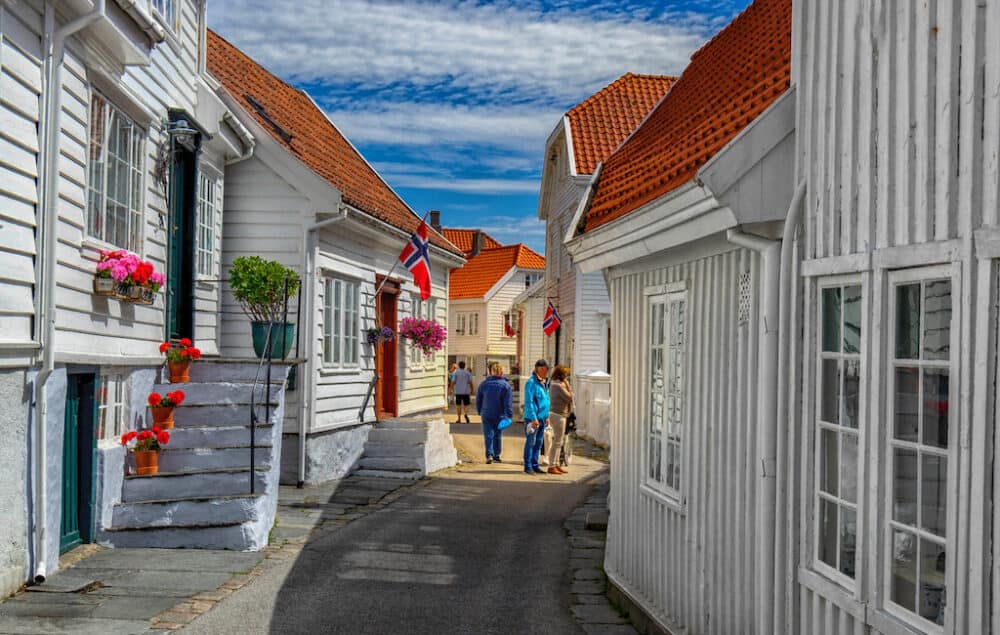

I thought this picturesque coastal town was super cute! I totally fell for its charming old town, with largely traffic-free, narrow winding streets lined by white wooden houses and a picturesque harbour, all set against a backdrop of open blue seas and distant islands. I also loved its relaxed, nostalgic vibe and charming nautical feel.
Nestled on the southern tip of Karmøy Island in Rogaland County, in southwestern Norway, it was originally a historic fishing village founded in the 19th century. Today, with a population of around 3,300, it remains one of the country’s best-preserved towns from the sailing ship era.
It was a four hour drive from Bergen and I stayed for two days in the summer. When here, I wandered through the idyllic Old Skudeneshavn and browsed the quaint cafes, charming local shops, and art galleries, visited the Maritime Museum and delved into the town’s seafaring past, relaxed on the beautiful sandy Sandvesanden beach, explored the Mælandsgården Museum and learnt about 19th-century life there, and enjoyed the annual Skudefestivalen, which celebrated traditional Norwegian boats and culture!
- Location: Southwestern coast, on the island of Karmøy.
- Best time to visit: Summer (for warm temperatures and coastal walks through the charming village).
- Activities on offer: Walking tours through historic streets, visiting the old town, exploring nearby beaches, and enjoying local seafood.
- Accommodation: Parken Terrace Hotel, Karmøy Kystferie, and Skudenes Camping.
- Map Location and Directions
My favourite highlights…
- Visiting the Majorstuen Antikviteter – I loved the quirky nostalgic decor which came complete with carved wooden chests, old pianos, bronze candlesticks, antique art, the super friendly elderly couple who ran it (Johannes had so many stories to tell!) and tasting incredible waffles which came with raspberry jam.
10. Fredrikstad


This historic city has a reputation for having the best-preserved old towns in Scandinavia! I thought it was stunning for its impressive, well-preserved fortifications of the Old Town (Gamlebyen) which had cobblestone streets lined by charming historic buildings and bustling market squares. It loved its relaxed, historical vibe as well as its vibrant arts scene.
Located in southeastern Norway at the mouth of the Glomma River, about 90 kilometers south of Oslo, it was founded in 1567 and is known for its well-preserved fortress. As the country’s sixth-largest city, it has a population of around 83,000 residents
I drove an hour from Oslo (there were also train and bus options) and spent two days there. I explored the fascinating historic Old Town (Gamlebyen), visited the Fredrikstad Museum and delved into the city’s history, walked along the city walls and saw superb panoramic views, enjoyed arts and performances at Blå Grotte, shopped at the vibrant farmers’ market, browsed quaint stores and antique shops and took a boat trip along the Glomma River to see the city from a different perspective!
- Location: Southeastern part of the country.
- Best time to visit: Spring and Summer (for exploring the old town and enjoying outdoor activities by the river).
- Activities on offer: Exploring the old town, cycling along the river, walking tours, and enjoying local markets.
- Accommodation: Hotel Fredrikstad, Quality Hotel Fredrikstad, and Gamlebyen Hotell.
- Map Location and Directions
My personal highlights…
- Exploring the more modern part of the town Vestsiden (West Side), which is part of the modern city centre and stumbling across the Fredrikstad Cathedral featuring stunning stained-glass work by Emanuel Vigeland and a striking steeple!
11. Jotunheimen National Park




This was a vast and remote mountainous wilderness! I found that the country’s most popular national park was home to truly jaw-dropping scenery, with dramatic alpine landscapes, towering peaks, glacial valleys, turquoise mountain lakes, stunning rocky and glacial shores, and charming mountain lodges – all set against untouched, protected wilderness It had a wild and adventurous feel, making it the perfect place for me to embrace solitude!
Located in the southern part of the country, it spanned the counties of Innlandet and Vestland, between Oslo and Bergen. Established in 1980, it covered around 1,151 square kilometres and is steeped in folklore and Norse legends. A haven for outdoor adventures, it attracted hikers, cross-country and alpine skiers, cyclists, and climbers from all over Europe.
It boasts the largest concentration of mountains over 2,000 meters in Northern Europe, including the country’s 29 highest peaks, with Galdhøpiggen (2,469m) standing as the tallest. Alongside its unique Arctic-alpine flora, the park is home to diverse wildlife, including reindeer, foxes, martens, wolverines, lynx, and the rare golden eagle!
It took me a five hour drive from Oslo and I stayed for an adventurous three days, I hiked the famous Besseggen Ridge and saw breathtaking views over Gjende and Bessvatnet lakes, climbed the country’s highest peak, Galdhøpiggen, trekked through the remote Utladalen Valley, explored the stunning glaciers of Smørstabbrean and stayed overnight at the Gjendesheim the scenic mountain lodge.
- Location: Central part of the country.
- Best time to visit: Summer (for hiking trails and enjoying Norway’s highest peaks.
- Activities on offer: Hiking, mountaineering, wildlife viewing, glacier walks, and camping.
- Accommodation: Elveseter Hotel, Spiterstulen Lodge, and Gjendesheim Tourist Lodge.
- Map Location and Directions
- Jotunheimen National Park
My personal highlights…
- Learning from the local guides about why it was known as the “Home of the Giants” – they told me that according to local legend’s mythical ancient Jotuns (giants) roamed the vast wilderness!
12. Svalbard




This was a remote and otherworldly Arctic archipelago! I discovered a breathtaking and unique beauty spot filled with vast icy landscapes, towering glaciers, and snow-covered mountains, which were contrasted by the colourful wooden buildings of the small town of Longyearbyen, which really stand out against the stark Arctic wilderness!
To me it felt raw and adventurous with a mysterious and otherworldly Arctic atmosphere and I loved getting a glimpse into how a very hardy community lived on the edge of the world!
It was tucked away in the Arctic Ocean, between the country’s mainland and the North Pole, around 800 kilometres north of the Norwegian mainland. It was first discovered by Dutch explorers in 1596 and later settled for coal mining.
It’s actually one of the northernmost permanently inhabited places on Earth, with around 2,500 residents (mostly settled in Longyearbyen), and it’s also a fantastic wildlife-spotting destination where polar bears, Svalbard reindeer, walruses, and Arctic foxes roam its remote lonely lands.
I took a three hour direct flight from Oslo to Longyearbyen (the main settlement) and spent four days here. When here, I explored the interesting colourful town of Longyearbyen, took a boat trip to the stunning Nordenskiöld Glacier, spotted the very important Global Seed Vault, saw magnificent polar bears, explored ice caves beneath glaciers, and even manage to experience the magical Northern Lights!
- Location: Arctic Ocean, north of mainland Norway.
- Best time to visit: Late Spring to Summer (for experiencing the Midnight Sun and wildlife sightings).
- Activities on offer: Glacier kayaking, hiking, snowmobiling, and wildlife viewing, including polar bears.
- Accommodation: Radisson Blu Polar Hotel, Svalbard Hotel, and Basecamp Hotel.
- Map Location and Directions
My personal highlights…
- Going on a guided boat tour which I booked in the city centre to Moffen Island was was known walrus sanctuary – we had to stay 300 meters away due to strict protection laws but it was amazing to see them noisily lounge around on the island’s beaches!
13. Reine




I was in awe of this picturesque Lofoten Island village! I loved its breathtaking and dramatic fjord setting, where towering peaks rose sharply from the blue-green waters, traditional red rorbuer fishing cabins lined the shore, and crystal-clear waters reflected the stunning Arctic landscape!
I loved how peaceful and awe-inspiring it felt, with a unique blend of traditional fishing village charm and the raw, dramatic beauty of the Arctic wilderness!
It was tucked away in the Lofoten Islands, in the northern part of the country, on the island of Moskenesøya, along the scenic E10 highway. It’s was home to around 300 people, and has been a key fishing hub for centuries.
I flew into Leknes, then drove along the E10 highway and stayed for a dreamy three days. I hiked the iconic Reinebringen and saw breathtaking panoramic views, stayed in a traditional red rorbuer cabin by the water, kayaked through the scenic Reinefjorden, took a boat trip to the remote village of Vindstad and hiked to Bunes Beach, visited the charming Reine Cultural Center, and explored the nearby pretty fishing villages of Hamnøy and Sakrisøy.
- Location: Northern part of the country, in the Lofoten archipelago.
- Best time to visit: Summer (for scenic hikes and views of the fjords during the Midnight Sun).
- Activities on offer: Hiking Reinebringen, boat tours through fjords, and photography.
- Accommodation: Reine Rorbuer, Eliassen Rorbuer, and Sakrisøy Rorbuer.
- Map Location and Directions
My favourite highlights…
- Staying Reine Rorbuer – by Classic Norway Hotels – I was totally charmed by the tastefully renovated traditional fishermen’s cabins (rorbuer) that have been thoughtfully converted into cosy rustic-chic havens – mine came with a handy kitchenette, locally hand crafted red rugs and incredible Arctic Ocean and mountain views!
14. Rondane National Park




This is the oldest National Park in the country! I thought it was stunning, with craggy mountain peaks, rolling plateaus, glacial lakes, and vast, rugged open landscapes. I was completely taken by its tranquil and wild vibe – it had a remote atmosphere that made me feel fully immersed in unspoiled nature!
Located in central Norway, it spans the counties of Innlandet and Trøndelag, between Oslo and Trondheim. Established in 1962 as Norway’s first national park, it covered 963 square kilometers and is home to one of Europe’s last wild reindeer herds.
I drove four hours from Oslo and stayed for three days, I hiked the scenic Rondslottet, the highest peak at 2,178 meters, explored the tranquil Rondvatnet Lake, spotted wild reindeer roaming the vast plateaus, trekked the iconic Dørålseter to Bjørnhollia route, stayed in the traditional mountain lodge Smuksjøseter, and experienced breathtaking views along the Rondane Triangle hiking trail!
- Location: Eastern part of the country.
- Best time to visit: Summer (for hiking and enjoying Norway’s oldest national park).
- Activities on offer: Hiking, wildlife spotting, photography, and camping.
- Accommodation: Rondane Høyfjellshotell, Spidsbergseter Resort, and Rondvassbu Lodge.
- Map Location and Directions
- Rondane National Park
My favourite highlights…
- Trekking the 17 kilometers Venabygdsfjellet to Mysusæter trail which was a bit of a challenge as it took 6 hours to complete! It took me through open mountain plateaus, lush birch forests, pretty purple Alpine flowers, spectacular views of the surrounding Rondane mountains and the occasional traditional Norwegian cabins which were known as hytters!
15. Trondheim




I thought this historic city was a real gem! I discovered it very attractive place with an Insta-worthy scenic waterfront nestled along the Nidelva River, colourful wooden wharfs at Bakklandet, and the stunning medieval Nidaros Cathedral which was a Gothic masterpiece!
I was completely won over by its lively yet quaint and cozy vibe. It felt both historical and timeless, yet still full of youthful energy from its university, along with a thriving cultural and food scene.
Located in central Norway along the Trondheimsfjord, about 500 km north of Oslo, it was founded in 997 AD as Norway’s first capital. Today, it is the country’s third-largest city, home to around 210,000 people, and is famous for its rich Viking history and the iconic Nidaros Cathedral.
It was a seven hour drive from Oslo but I thought it was worth it! I stayed for a long weekend and explored the majestic Nidaros Cathedral, walked through the charming Bakklandet district which had colourful wooden houses, visited the Old Town Bridge (Gamle Bybro) and saw gorgeous river views, admired historical artefacts at the Archbishop’s Palace Museum, took in panoramic cityscapes from Kristiansten Fortress, walked across the attractive Old Town Bridge which was built in 1681 and enjoyed the lively waterfront atmosphere at Solsiden which was filled with trendy restaurants and cafés.
- Location: Central part of the country.
- Best time to visit: Summer (for festivals, cultural events, and exploring the Nidaros Cathedral).
- Activities on offer: Visiting Nidaros Cathedral, exploring Bakklandet, cycling along the river, and enjoying local cuisine.
- Accommodation: Britannia Hotel, Clarion Hotel Trondheim, and Scandic Nidelven Hotel.
- Map Location and Directions
My highlights…
- Dining at the very creative and trendy Troll Restaurant – I loved the unique forest decor, the soft, dim lights (where I almost felt like I was in a troll’s cave!) and how my dish was garnished with locally grown edible flowers!
16. Stavanger




This gorgeous coastal city really wowed me! I was completely charmed by its mix of charming white and colourful wooden houses, stunning fjord landscapes, scenic harbours, soft sandy beaches and impressive historic landmarks. It felt vibrant yet laid-back vibe, with an inviting historic charm and a thriving food and arts scene.
- Location: Southwestern coast of the country.
- Best time to visit: Summer (for hiking to Pulpit Rock and enjoying outdoor activities along the coast)
- Activities on offer: Hiking to Pulpit Rock, fjord cruises, exploring the old town, and visiting museums.
- Accommodation: Ydalir Hotel, Radisson Blu Atlantic Hotel, and Clarion Hotel Stavanger.
- Map Location and Directions
My highlights…
- Browsing the cute Kant boutique gift store which was filled with locally produced high quality artisan produced gifts including maritime themed items – I especially loved the cute lighthouse, anchors, the cosy Nordic jumpers, the cool hand printed cow T-shirts and the beautiful crab coffee mugs!
17. Nigardsbreen Glacier




This was a spectacular part of the Jostedalsbreen Glacier! I have to admit I was in awe of this spectacular beauty spot which had striking blue ice, dramatic crevasses, and towering glacial formations, all set against the rugged mountain landscapes of Jostedalsbreen National Park. It felt raw and adventurous, with an awe-inspiring, otherworldly vibe and a sense of untouched Arctic wilderness!
- Location: Western part of the country.
- Best time to visit: Summer (for glacier hiking with guided tours and favourable weather conditions).
- Activities on offer: Glacier hiking, guided tours, photography, and visiting nearby lakes.
- Accommodation: Nigardsbreen Lodge, Jostedal Hotel, and Sognefjord Hotel.
- Map Location and Directions
My favourite highlights…
- Seeing the incredible ice caves which were filled with brilliant blue hues, a fascinating array of patterns including ripples and pitting on the cave walls and the echoey sound of my voice made which created a unique auditory experience!
18. Femundsmarka National Park




This was a remote and unspoilt wilderness area! I also thought it was beautiful for its vast, untouched areas of wilderness, shimmering lakes, ancient pine forests, rugged mountains, and a tranquil, off-the-grid atmosphere that felt truly raw and wild!
- Location: Eastern part of the country.
- Best time to visit: Late Spring to Summer (for hiking, and exploring Norway’s wilderness).
- Activities on offer: Hiking, canoeing, wildlife viewing, and camping.
- Accommodation: Røros Hotel, Femund Fjellstue, and Roste Hyttetun & Camping.
- Map Location and Directions
- Femundsmarka National Park
My personal highlights…
- Hiking the very scenic 10km Elgåhogna Trail which me five hours on an moderately steep elevation eventually reaching the summit of Elgåhogna (which is the highest peak in the area) – once there I could see incredible panoramic views of the vast Femunden lake and the surrounding wilderness.
19. Solund




This was a remote and rugged island! I thought it was postcard-perfect, with dramatic coastal scenery featuring thousands of scattered islets, rugged cliffs, and charming fishing villages with traditional wooden boathouses and white-painted homes, all set against the backdrop of the open North Sea. It felt wild and tranquil, with an untouched coastal escape vibe that really drew me in!
Norway’s westernmost island municipality, it sits at the outermost edge of Sogn og Fjordane, where the Sognefjord meets the North Sea. Historically a fishing and maritime community, it is now home to around 750 people.
I caught an express boat from Bergen which took 2.5 hours to Hardbakke (its municipal centre) and stayed for an idyllic two days. I explored the stunning island-dotted seascape by kayak, visited the Utvær Lighthouse (which was Norway’s westernmost point) hiked the rugged trails of Ramsdalsheia, discovered the region’s maritime history at the Solund Coastal Museum, and navigated through the narrow tidal straits of Nærøyfjorden’s outermost reaches on a fun skippered RIB (rigid inflatable boat) tour!
- Location: Western part of the country, in the Sognefjord region.
- Best time to visit: Summer (for boating, hiking, and exploring the scenic archipelago).
- Activities on offer: Boating, kayaking, hiking coastal trails, and exploring the archipelago.
- Accommodation: Solund Leilighetshotell, Hardbakke Gjestehus, and Solund Rorbuferie.
- Map Location and Directions
My personal highlights…
- Going on the skippered boat tour was an awesome experience – picking up high speeds, darting through narrow inlets, getting up close to cascading waterfalls, and spotting gorgeous harbour seals sunbathing on craggy coastal rocks.
Location of Norway
Norway is located in the Nordic area of Northern Europe and the North Atlantic, along with Denmark, Finland, Iceland, Norway, Sweden, the Faroe Islands and Greenland.



